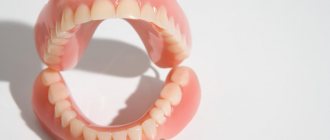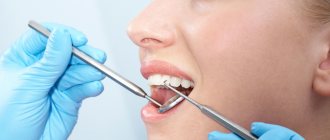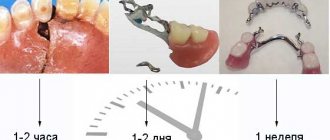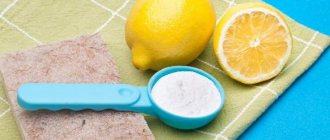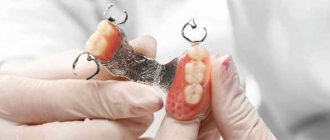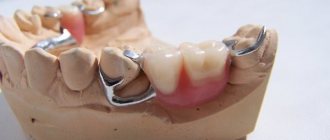Maintaining the integrity of teeth and their original natural appearance throughout life is quite difficult. There are many reasons for this: a poor environmental situation, poor nutrition, insufficient oral hygiene, heredity and bad habits. If you lose even one tooth, you should immediately contact an orthopedic dentist. Dentures can help eliminate problems caused by tooth loss. Today, patients are offered a huge number of them, the main thing is to understand which type is better to give preference.
Modern methods of prosthetics
In dental practice, different methods of prosthetics are used, their choice depends on the characteristics and condition of the patient’s oral cavity, as well as on the number of healthy teeth.
The following methods of dental restoration are distinguished:
1. Removable dentures. These include structures that can, if necessary, be independently removed from the oral cavity and installed back. They consist of a main plastic or nylon part on which artificial teeth made of the material chosen by the patient are fixed. Such dentures can be fully or partially removable.
2. Fixed dentures. They are installed for constant wear and can only be removed by a doctor. There are the following types:
- implants are an innovative method of prosthetics that involves implanting a durable screw into the bone. In the future, it will become a reliable support for an artificial crown or prosthesis. There is no need to grind down adjacent teeth;
- A crown on a tooth is a product that exactly repeats the shape of the tooth and allows you to restore its chewing function. This design is used when the root is not damaged, but the integrity of the tooth is compromised. A crown covers a damaged tooth, restores its shape and prevents further decay. It can be made of different materials: ceramics, metal-plastic and metal-ceramics, both in a single form and in a bridge form.
- Bridges are crowns connected to each other, forming a single bridge-like structure. You can restore several teeth at the same time, but you will need to grind down the adjacent healthy teeth;
- veneers are ultra-thin, but at the same time quite durable ceramic plates that are installed on the outer surface of the tooth. They are used when the integrity of the tooth is not severely compromised, and are intended to eliminate external defects of the teeth that fall into the smile area;
- inlays are durable dental products made of ceramics or metal-ceramics. They are used instead of fillings to restore a badly damaged tooth, but with a well-preserved root.
3. Partially removable dentures. They are usually installed when there are several teeth to fix them, and there is no need to grind them down. Often, such models are attached to supporting teeth using dental hooks or locks: clasps, attachments or telescopic crowns. May be of the following types:
- lamellar. Budget-friendly design, easy to use;
- clasp Sufficiently durable, reliable and robust design;
- immediate dentures (so-called butterfly). Used for temporary replacement of lost teeth in preparation for basic prosthetics;
- removable sectors. They are a good option for loss of chewing teeth.
Any of the above methods of prosthetics has its own characteristics and advantages, however, only a qualified dentist can correctly determine the need to use a particular product.
Artificial teeth. Types and materials
Thanks to modern technologies and the latest developments in the field of medicine, today it is possible to produce various types of artificial teeth, which for many years will retain their original appearance and perfectly perform their main function.
There are many different ways to make artificial teeth, and there are many techniques for installing these teeth. Both an individual tooth and an entire row of teeth can be reconstructed for any jaw - upper or lower. The choice of materials from which artificial teeth can be made is huge, and therefore the number of varieties of such products is also large.
Artificial teeth are made from materials that can be biologically combined with the tissues of the oral cavity. A tooth can be made individually for each person. In this case, the features of the anatomical relief are taken into account.
Materials
The materials that are used today to create artificial teeth have fairly high strength, sufficient for the product to withstand any load. But this, of course, does not mean that the installed teeth need to be urgently checked with dense materials, such as metal products, nut shells, etc. At least, with such teeth you can chew ordinary food without worry, without fear that they will be destroyed.
An artificial tooth can be made in the form of a crown or in the form of an entire real tooth.
Individual artificial teeth are most often made of ceramic. Ceramic crowns can be framed or frameless. They do not contain metal, they consist entirely of ceramics. These teeth are made from liquid ceramic mass. It is compressed under great pressure, and as a result, a product of the desired shape is formed. Also, such teeth can be produced using machines with high precision. Often, a ceramic artificial tooth can consist of two types of ceramics. When making such teeth, one layer of ceramic is applied to another. The result is a highly durable structure.
An artificial tooth can be made from two different materials, such as ceramic and metal. In this case, it will be called metal-ceramic. Metal is the basis of such a dental product. And on top it is covered with a layer of ceramics. In this case, various alloys can act as a metal base: chrome, titanium, etc. Such products can be crowns, whole teeth or dentition. Usually, once they are installed in the oral cavity, they cannot be removed. However, there are also removable products.
The tooth can be made entirely of metal. In this case, alloys of various metals are also used, including precious ones.
Another material that is suitable for making artificial teeth is plastic. Plastic dental products are most often removable dentures. They are often worn before permanent ceramic or metal artificial teeth are installed.
A special type of dental products includes artificial teeth mounted on implants. Installing such teeth is a very long process that takes place in several stages. First, an implant is implanted into the bone, and then a crown is attached to it. Before installing teeth on implants, the patient must undergo a special examination, as a result of which it will be accurately determined whether this person can even have implants implanted into the bone.
With the use of innovative dental materials, today it is possible to produce not only teeth, but also decorative overlays on them, which are needed in order to hide any visible defects. Externally, such onlays are practically indistinguishable from real teeth, and therefore the wearer can show off his beautiful smile to everyone.
Features and advantages of removable prosthetics
Removable dentures allow you to restore lost teeth in the most advanced and difficult situations. Even if the patient has only bare gums, this problem can be solved with their help.
Also, this type of dental structures has the following significant advantages:
- versatility. Removable models can be easily selected for a person of any age, with any number of remaining teeth and with completely different jaw structures;
- ease. The product contains virtually no metal elements, which allows for maximum lightness of the structure;
- speed of installation. The design is made according to an individual cast in 3-4 weeks;
- safety. The risks of damage to healthy teeth and their loss are minimal;
- availability. The price of such prostheses is significantly lower than that of fixed models.
Features and advantages of fixed prosthetics
Fixed dentures have gained wide popularity today due to the fact that they perfectly recreate the dentition and completely imitate natural teeth and their surface.
Their advantages are as follows:
- high strength. Non-removable models can easily withstand heavy loads, so the patient does not have to limit himself to solid food;
- durability. The structures can serve their owner for decades;
- quick addiction. Due to the absolute similarity with other teeth, the patient does not feel the difference and quickly gets used to the prosthesis;
- ease of care. No special care is required, just daily basic hygiene procedures are enough.
Implantation methods for complete absence of teeth
The use of modern restoration technologies has significantly improved the quality of life of edentulous people. Even after removing all units of the dentition, it is possible to completely restore chewing functions and the beauty of the smile.
Implants are used to attach removable and fixed prostheses. For people with complete edentia, the “all on 4” and “all on 6” methods (ALL ON 4 and “ALL ON 6”) have been developed. During the operation, artificial roots of a special design are installed in the basal layers of the jaw. The products serve as a support for bridges, which are fixed after a few days.
Removable dentures using implant systems involve the implantation of titanium rods into hard tissue. The orthopedic structure is tightly attached to the top of the implant using a micro-lock or a metal beam. This solves the problem of the artificial jaw falling out during conversation and eating, and restores the aesthetics of the smile.
Features of choice. Which dentures are best to install?
It’s easy to get confused in the existing variety of dentures, so it’s better to trust a professional orthopedic dentist who will select the right design just for you.
When choosing a denture, you should pay attention to the following nuances:
- number of teeth lost. If it is necessary to restore only one tooth, then the ideal solution would be to install an implant;
- comfort. It is worth understanding that removable dentures require special cleaning and disinfection using special solutions;
- waiting for the patient. If it is necessary to restore the upper row, then the most aesthetic models will be required for it, but if the lower row, the main thing will be the return of chewing functions;
- price. Fixed dentures will cost much more, but their price is fully justified.
Help from a qualified orthopedic dentist in Ivanteevka
You can make an appointment with an orthopedic dentist at Sanident Dentistry, one of the largest in Ivanteevka. The specialists of our clinic have extensive experience; in their work they use only the most modern methods of restoration and restoration of teeth, including the method of microprosthetics. The products we install are distinguished by their durability, aesthetics and safety. We regularly hold promotions and provide favorable discounts for our clients. We have the best prices in the region!
The comprehensive dental clinic "Sanident" is located at the following addresses:
- Ivanteevka, st. Novoselki, 4 (Ivanteevka railway station);
- Shchelkovo, st. Central, 80 (railway station Voronok).
High technology plus hygiene
Over the past 10 years, the number of contraindications to implantation has decreased significantly. The issues of survival of “artificial roots” have practically been resolved - their surfaces are now treated with titanium dioxide, due to this they reliably interact with bone tissue. Modern methods of maxillofacial surgery make it possible to successfully cope with a few “anatomical” contraindications for implantation - such as a too “narrow” jaw (that is, bone atrophy if the tooth was removed a long time ago) or too close location of the maxillary sinuses. There are not many real contraindications today. Basically we are talking about the presence of insulin-dependent diabetes mellitus, osteoporosis, dysfunction of the thyroid and parathyroid glands, metabolic disorders affecting the structure of bone tissue. There may also be problems with implants in people who have undergone chemotherapy treatment after cancer. Implantologists are also very critical of patients who do not take good care of their oral cavity. After all, it is very important to strictly follow the rules of hygiene, which play a key role in the success of the operation - both at the early stage of implant survival and throughout its entire lifespan. Recently, however, this circumstance can be completely corrected with the help of modern hygiene products and preventive manipulations by a dental hygienist. Another difficulty, albeit of a purely aesthetic nature, concerns those patients who have implants installed in the anterior part of the jaw (as they say, on the “facade”). It happens that in these places the bone is small, and the implant itself and the abutment (the connecting link between the implant and the crown) are made of titanium, so they begin to show through and the edge of the crown appears dark. To prevent this from happening, in recent years abutments made of zirconium oxide have been used - a high-tech material that is very similar in appearance to natural tooth tissue. In the field of implantology, Russian clinics today work at the world level, as they use all modern innovations and technologies. For patients who had implantation abroad, performing “current repairs” in Russia is also not a problem.
Prepared by Mila Blinova
AiF Health
